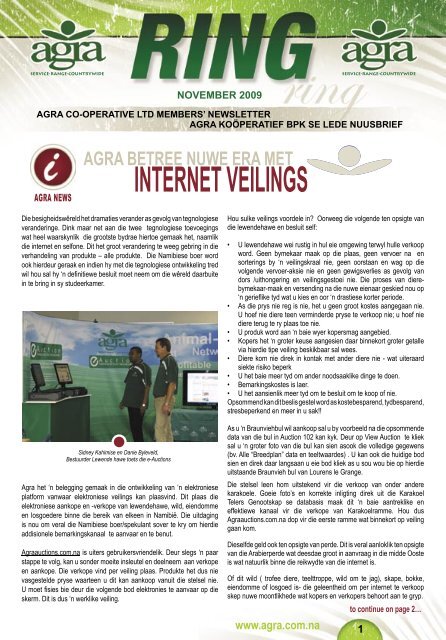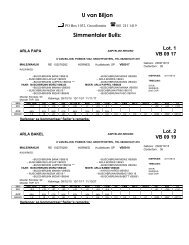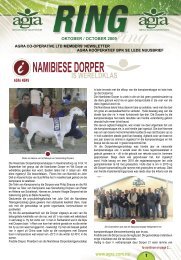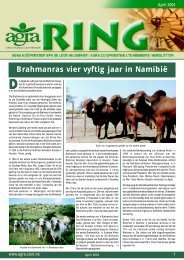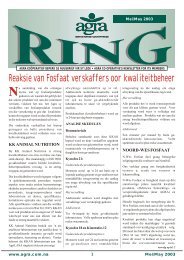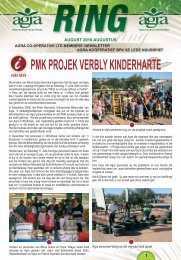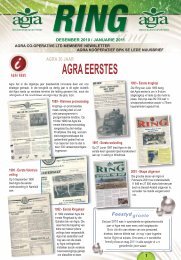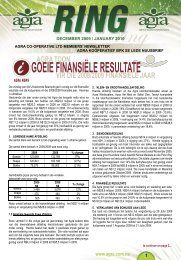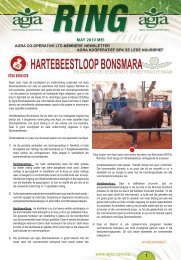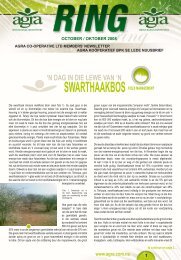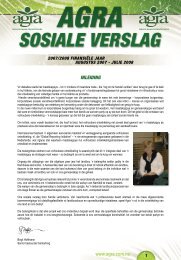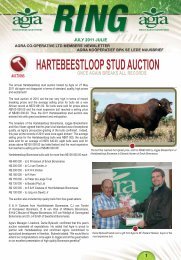agra betree nuwe era met
agra betree nuwe era met
agra betree nuwe era met
You also want an ePaper? Increase the reach of your titles
YUMPU automatically turns print PDFs into web optimized ePapers that Google loves.
service•range•countrywide<br />
AGRA CO-OPERATIVE LTD MEMBERS’ NEWSLETTER<br />
AGRA KOÖPERATIEF BPK SE LEDE NUUSBRIEF<br />
AGRA NEWS<br />
NOVEMBER 2009<br />
IS AGRA IT POSSIBLE? BETREE NUWE ERA MET<br />
INTERNET VEILINGS<br />
Die besigheidswêreld het dramaties v<strong>era</strong>nder as gevolg van tegnologiese<br />
v<strong>era</strong>nderinge. Dink maar net aan die twee tegnologiese toevoegings<br />
wat heel waarskynlik die grootste bydrae hiertoe gemaak het, naamlik<br />
die internet en selfone. Dit het groot v<strong>era</strong>ndering te weeg gebring in die<br />
verhandeling van produkte – alle produkte. Die Namibiese boer word<br />
ook hierdeur g<strong>era</strong>ak en indien hy <strong>met</strong> die tegnologiese ontwikkeling tred<br />
wil hou sal hy ‘n defi nitiewe besluit moet neem om die wêreld daarbuite<br />
in te bring in sy studeerkamer.<br />
Sidney Kahimise en Danie Byleveld,<br />
Bestuurder Lewende hawe toets die e-Auctions<br />
Agra het ‘n belegging gemaak in die ontwikkeling van ‘n elektroniese<br />
platform vanwaar elektroniese veilings kan plaasvind. Dit plaas die<br />
elektroniese aankope en -verkope van lewendehawe, wild, eiendomme<br />
en losgoedere binne die bereik van elkeen in Namibië. Die uitdaging<br />
is nou om v<strong>era</strong>l die Namibiese boer/spekulant sover te kry om hierdie<br />
addisionele bemarkingskanaal te aanvaar en te benut.<br />
Agraauctions.com.na is uiters gebruikersvriendelik. Deur slegs ‘n paar<br />
stappe te volg, kan u sonder moeite insleutel en deelneem aan verkope<br />
en aankope. Die verkope vind per veiling plaas. Produkte het dus nie<br />
vasgestelde pryse waarteen u dit kan aankoop vanuit die stelsel nie.<br />
U moet fi sies bie deur die volgende bod elektronies te aanvaar op die<br />
skerm. Dit is dus ‘n werklike veiling.<br />
www.<strong>agra</strong>.com.na 1<br />
service•range•countrywide<br />
Hou sulke veilings voordele in? Oorweeg die volgende ten opsigte van<br />
die lewendehawe en besluit self:<br />
• U lewendehawe wei rustig in hul eie omgewing terwyl hulle verkoop<br />
word. Geen bymekaar maak op die plaas, geen vervoer na en<br />
sorterings by ‘n veilingskraal nie, geen oorstaan en wag op die<br />
volgende vervoer-aksie nie en geen gewigsverlies as gevolg van<br />
dors /uithongering en veilingsgestoei nie. Die proses van dierebymekaar-maak<br />
en versending na die <strong>nuwe</strong> eienaar geskied nou op<br />
‘n geriefl ike tyd wat u kies en oor ‘n drastiese korter periode.<br />
• As die prys nie reg is nie, het u geen groot kostes aangegaan nie.<br />
U hoef nie diere teen verminderde pryse te verkoop nie; u hoef nie<br />
diere terug te ry plaas toe nie.<br />
• U produk word aan ‘n baie wyer kopersmag aangebied.<br />
• Kopers het ‘n groter keuse aangesien daar binnekort groter getalle<br />
via hierdie tipe veiling beskikbaar sal wees.<br />
• Diere kom nie direk in kontak <strong>met</strong> ander diere nie - wat uit<strong>era</strong>ard<br />
siekte risiko beperk<br />
• U het baie meer tyd om ander noodsaaklike dinge te doen.<br />
• Bemarkingskostes is laer.<br />
• U het aansienlik meer tyd om te besluit om te koop of nie.<br />
Opsommend kan dit beslis gestel word as kostebesparend, tydbesparend,<br />
stresbeperkend en meer in u sak!!<br />
As u ‘n Braunviehbul wil aankoop sal u by voorbeeld na die opsommende<br />
data van die bul in Auction 102 kan kyk. Deur op View Auction te kliek<br />
sal u ‘n groter foto van die bul kan sien asook die volledige gegewens<br />
(bv. Alle “Breedplan” data en teeltwaardes) . U kan ook die huidige bod<br />
sien en direk daar langsaan u eie bod kliek as u sou wou bie op hierdie<br />
uitstaande Braunvieh bul van Lourens le Grange.<br />
Die stelsel leen hom uitstekend vir die verkoop van onder andere<br />
karakoele. Goeie foto’s en korrekte inligting direk uit die Karakoel<br />
Telers Genootskap se databasis maak dit ‘n baie aantreklike en<br />
effektiewe kanaal vir die verkope van Karakoelramme. Hou dus<br />
Agraauctions.com.na dop vir die eerste ramme wat binnekort op veiling<br />
gaan kom.<br />
Dieselfde geld ook ten opsigte van perde. Dit is v<strong>era</strong>l aanloklik ten opsigte<br />
van die Arabierperde wat deesdae groot in aanvraag in die midde Ooste<br />
is wat natuurlik binne die reikwydte van die internet is.<br />
Of dit wild ( trofee diere, teelttroppe, wild om te jag), skape, bokke,<br />
eiendomme of losgoed is- die geleentheid om per internet te verkoop<br />
skep <strong>nuwe</strong> moontlikhede wat kopers en verkopers behoort aan te gryp.<br />
to continue on page 2…
EDITORIAL<br />
Sommige boere was gelukkig<br />
om al in hierdie seisoen welkome<br />
reenbuie te ontvang. Vir die<br />
meeste van ons is die afwagting<br />
egter steeds groot en as ons na<br />
die weerprofete luister, maak<br />
ons ons reg vir ‘n droë en warm<br />
somer. In hierdie uitgawe gee Dr<br />
Rothauge juis raad vir boere ten<br />
opsigte van u weidingsbestuur<br />
in die lig van die voorspelde<br />
periode. Dr Hassel kyk verder na<br />
soonotiese siektes en bespreek<br />
‘n paar belangrike siektes in<br />
hierdie uitgawe. Ons bring u ook<br />
veilingsuitslae en ander nuus,<br />
wenke vir organiese tuine en<br />
die gereelde artikel rakende die<br />
arbeidswet.<br />
Ons ontvang gereeld komplimente<br />
vir die waardevolle<br />
artikels wat geplaas word in die Ring, asook<br />
versoeke dat dit ook in Afrikaans geplaas<br />
word. Ons poog om die artikels afwisselend<br />
in Afrikaans en Engels te plaas, maar<br />
aangesien die bronne van baie artikels in<br />
Engels is, sal dit addisionele tyd en kostes<br />
vereis om dit vir u in Afrikaans te bied. Ons<br />
neem egter u versoeke ter harte en ons dank<br />
u vir u terugvoer.<br />
Agra het huidig ongeveer 4 500 lede. Agra<br />
is sy lede, en Agra se lede speel ‘n baie<br />
belangrike rol in die besluite wat geneem<br />
word rakende die besigheid. Op 27 November<br />
is die Algemene Jaarvergadering van Agra.<br />
In die belang van Agra, u belangrike vennoot<br />
in landbou, wil ons u versoek om hierdie<br />
jaarvergadering by te woon. Ons vertrou<br />
dat ons boere van dwarsoor Namibie op 27<br />
November in Windhoek by die Agra Bank<br />
Windhoek Ring sal sien.<br />
Groete tot dan.<br />
Albé Snyman<br />
Kommunikasiebeampte<br />
Privaatsak 12011, Windhoek<br />
Tel: 061-290 9273<br />
Epos: albes@<strong>agra</strong>.com.na<br />
Agra Head Offi ce<br />
Tel: 061-290 9111<br />
2<br />
www.<strong>agra</strong>.com.na<br />
...continued from page 1<br />
As u op soek is na ‘n beproefde Brahmanbul kan u na veiling<br />
100 kyk. U kan weer eens meer data van die bul sien deur op<br />
View Auction te kliek. U kan egter ook op Mecki en Brigitte<br />
Schneider se FARM SITE kliek en baie meer van die OKABRA<br />
stoet daar lees. CLAWA hieronder het ‘n groot bydrae in die<br />
OKABRA stoet gelewer en behaal ook nou die onderskeiding<br />
dat dit die eerste dier is wat op Agraauctions.com.na gelys is<br />
vir verkope.<br />
Agra onderneem om die ook hier ‘n diens van hoogstaande<br />
gehalte te bied.<br />
Agra nooi u uit op van hierdie diens gebruik te maak. Om maklik en gou kontak te maak kliek<br />
u in Agraauctions.com.na op Contact Us Die onderstaande kontakbesonderhede sal dan<br />
ook daar verskyn:<br />
Sidney Kahimise: sidneyk@<strong>agra</strong>.com.na Cell +264 81 236 0290<br />
Pieter Hugo: pieter@<strong>agra</strong>.com.na Cell +264 81 127 8522<br />
Accounts: accounts@<strong>agra</strong>auctions.com.na<br />
Administration: admin@<strong>agra</strong>auctions.com.na Offi ce +264 61 2909208<br />
OR +264 61 2909263<br />
Agraauctions.com.na neem u boerdery buite bestaande grense.<br />
U kan dit nie bekostig om nie van hierdie diens gebruik te maak nie!<br />
Vir meer inligting kontak<br />
Sidney (081 324 6079)<br />
Pieter (081 127 8522) of<br />
Marieta (061 2909208)<br />
Sidney Kahimise, Bestuurder<br />
Agra e-Auctions
KARAKUL<br />
KARAKOELPRODUSENTE<br />
Die jaarlikse Karakoel Produsente Forum(KPF) het plaasgevind op<br />
Dinsdag, 22 September 2009 te Keetmanshoop. Die Forum was ‘n groot<br />
sukses <strong>met</strong> meer as 50 karakoel produsente en belangstellendes van<br />
dwars oor die land en ook Suid Afrika wat die vergadering bygewoon<br />
het.<br />
Ten spyte daarvan dat die gemiddelde pelsprys tydens die afgelope<br />
twee veilings gedaal het, het daar steeds ‘n positiewe gesindheid onder<br />
die produsente geheers.<br />
Die voorsitter van die Karakoelraad van Namibië, mnr Kobus van Wyk<br />
som die jaar so op;<br />
“Die afgelope 5 jaar was ‘n baie voorspoedige tydperk in die pelsindustrie.<br />
Die pels is reeds ‘n geruime tyd in die mode maar die weer en ekonomie<br />
werk nie saam nie. Die Karakoelraad probeer <strong>met</strong> sy beperkte menslike<br />
en fi nansiële hulpbronne, markkennis en -ervaring, maksimum<br />
produksiebevordering en produkpromosie te doen. Dit is nie altyd maklik<br />
om die sukses van projekte te meet nie maar die feit is dat swakara<br />
uitstaan as ‘n gesogte en gewaardeerde produk in die pelsindustrie.<br />
Ongelukkig word hierdie status nie konstant weerspieël in die pryse wat<br />
ons pelse op die veilings behaal nie.”<br />
Die volgende belangrike besluite is geneem op die KPF 2009:<br />
HEFFINGS<br />
Die bestaande heffi ngs van N$4.00 heffi ng en N$4.00 spesiale heffi ng<br />
verhoog na N$12-00 (N$6-00 heffi ng en N$6-00 spesiale heffi ng) of 4%<br />
van nasionale bruto pelsgemiddeld, welke bedrag die hoogste is wat dan<br />
50/50 verdeel word tussen die heffi ng en spesiale heffi ng.<br />
RSA produsente sal dieselfde bydrae maak tot albei hierdie fondse.<br />
Wessel en Marie Visser <strong>met</strong> die Goue Lam toekenning<br />
IS HOU IT POSSIBLE?<br />
VERGADERING<br />
NAVORSINGSFONDS<br />
Die vergadering het `n nie-statutêre aftrekking van N$3-00 per pels<br />
goedgekeur vir toekomstige navorsing, voorligting en opleiding.<br />
Die fonds sal buite die Raad geadministreer word, heel waarskynlik<br />
deur die organisasie wat benoem sal word vir die koördinering van<br />
navorsingsprojekte, voorligting en opleidingskursusse.<br />
NCA HEFFING - dit is heffi ngs wat reeds deur vleisprodusente suid van<br />
die Noordelike Veterinêre Kordonheining of sogenaamde Rooilyn betaal<br />
word om te help <strong>met</strong> die verbetering in die dieregesondheidstatus noord<br />
van die Rooilyn.<br />
Hierdie bestaande heffi ng op lewende hawe wat geslag word, word<br />
aangewend om te help <strong>met</strong> die bekamping van siektes bokant die<br />
Rooilyn en die opgradering van die gesondheidstatus. Veesiektes bokant<br />
die Rooilyn kan `n invloed hê op die uitvoer van pelse en daarom het die<br />
vergadering `n bydrae van N$1 per pels goedgekeur. Die Karakoelraad<br />
sal self die fonds bestuur.<br />
Die Karakoel Produsente Forum se Gala Dinee wat gehou was<br />
op 22 September in Keetmanshoop was weer eens ‘n reuse<br />
sukses. Die glansgeleentheid was onder andere deel van die 90ste<br />
bestaansjaarvieringe van die Karakoel Telers Genootskap.<br />
By hierdie spoggeleentheid is rolspelers, produsente en telers ook<br />
vereer. Daar was onder andere pryse toegeken vir die Beste swakara<br />
produsent, die Top Tien, Goue Lam Toekenning en Kopenhagen Fur /<br />
AGRA Kwaliteit toekenning.<br />
Piet Steenkamp ontvang sy Kopenhagen Fur/Agra Kwaliteit Toekenning<br />
www.<strong>agra</strong>.com.na 3
Die volgende pryse is oorhandig:<br />
Top Tien:<br />
PA Karsten<br />
Lovedale Farming cc<br />
JHK Vlok<br />
GT Karsten<br />
A & H Farmpartners<br />
Wyle JT Meyer<br />
LJ Kotze<br />
PJH Jacobs<br />
D Motinga<br />
P Steenkamp<br />
Beste- en Naasbeste Pelsprodusent:<br />
A&H Farm Partners<br />
Wyle JT Meyer<br />
Goue Lam toekenning :<br />
WH Visser<br />
Kopenhagen Fur / AGRA Kwaliteit toekenning:<br />
P Steenkamp<br />
Die Top Tien Karakoelprodusente saam <strong>met</strong> Agra se Senior Bestuurder:<br />
Korporatiewe Aangeleenthede, Birgit Hoffmann<br />
4<br />
www.<strong>agra</strong>.com.na<br />
Op 23 September is die Elite ramveiling gehou. Die verbasing<br />
was groot dat die daling in pelsprys nie ‘n effek op die rampryse<br />
gehad het nie. Al 74 ramme is verkoop teen ‘n gemiddelde prys<br />
van N$10 013.<br />
Na die ramveiling is A&H Farmpartners se uitverkoping van wit ooie<br />
en ramme aangebied. Al die diere is ook verkoop teen ‘n gemiddelde<br />
prys van N$ 1 542 per ooi en N$ 6 333 per ram.<br />
Dit is <strong>met</strong> leedwese dat ons kennis geneem het van die<br />
afsterwe van Truter Meyer, een van die vasbyters en<br />
topproduseerders in die Karakoelbedryf. Ons innige<br />
meegevoel <strong>met</strong> sy familie. Baie sterkte aan Julene en Elma<br />
wat voortgaan <strong>met</strong> die boerdery.<br />
Jack Albertyn Beste Karakoelprodusent en<br />
wyle Truter Meyer saam <strong>met</strong> Birgit Hoffmann<br />
The re-opening of the new Mariental branch took place from 22-27 November...more in the next edition of the RING
NOTICE<br />
GOUE LAM ERETOEKENNINGS<br />
KENNISGEWING VAN DIE 29ste<br />
ALGEMENE JAARVERGADERING<br />
VAN LEDE VAN AGRA (KOÖPERATIEF) BEPERK<br />
KENNIS geskied hiermee van die nege-en-twintigste Algemene Jaarvergadering<br />
van Lede van AGRA (KOÖPERATIEF) BPK. wat gehou sal word op die plek en datum<br />
soos hieronder aangedui.<br />
PLEK: Agra/Bank Windhoek Ring<br />
Windhoek Skougronde, Bell Straat, Windhoek<br />
DATUM: 27 NOVEMBER 2009<br />
TYD: 09:00 (registrasie 08:30)<br />
IN OPDRAG VAN DIE RAAD<br />
L van Wyk - Sekretaris, Privaatsak 12011, WINDHOEK<br />
11 September 2009<br />
NOTICE OF THE 29th ANNUAL GENERAL MEETING OF<br />
AGRA (CO-OPERATIVE) LIMITED<br />
NOTICE is hereby given that the twenty ninth Annual Gen<strong>era</strong>l Meeting<br />
of members of AGRA (CO-OPERATIVE) LIMITED will be held at<br />
the place and date as mentioned below.<br />
PLACE: Agra/Bank Windhoek Ring<br />
Windhoek Showgrounds, Bell Street, Windhoek<br />
DATE: 27 NOVEMBER 2009<br />
TIME: 09:00 (registration 08:30)<br />
BY ORDER OF THE BOARD:<br />
L van Wyk - Secretary, Private Bag 12011, WINDHOEK<br />
11 September 2009<br />
www.<strong>agra</strong>.com.na 5
SAKELYS VIR DIE<br />
29ste ALGEMENE JAARVERGADERING<br />
1. Opening, verwelkoming en konstituering<br />
2. Goedkeuring van die notule van die Agt en Twintigste<br />
Algemene Jaarvergadering van lede soos gehou op 27<br />
November 2008 te Windhoek<br />
(Bogenoemde notule sal by alle takke ter insae wees)<br />
3. Oorsig deur die Hoof Uitvoerende Beampte ten opsigte<br />
van die fi nansiële jaar geëindig 31 Julie 2009<br />
4. Goedkeuring van:-<br />
4.1 Verslag van die Raad van Direkteure<br />
4.2 Honorarium van Direkteure en Toesighoudende<br />
Komiteelede<br />
4.3 Ouditeursvergoeding vir die afgelope fi nansiële jaar<br />
4.4 Finansiële state soos op 31 Julie 2009<br />
5. Begroting 2009/2010<br />
5.1 Oorsig<br />
5.2 Goedkeuring<br />
6. Verkiesing van Direkteure:<br />
VAN AGRA (KOÖP) BPK OP 27 NOVEMBER 2009<br />
Streek 1 (Noord)<br />
Herkiesbaar: Mnr P Schonecke<br />
Geen nominasies ontvang<br />
Streek 3 (Suid)<br />
Herkiesbaar: Mnr LC van Wyk<br />
Herkiesbaar: Mnr JW Visagie<br />
Geen nominasies ontvang<br />
Aanwys van Toesighoudende Komitee Lede:<br />
Streek 1 (Noord)<br />
Een vakature<br />
Geen nominasies ontvang<br />
Streek 3 (Suid)<br />
Een vakature<br />
Genomineer: Mnr JH Nieuwoudt<br />
7. Intrekking van aandele kragtens Artikel 10.3 van die Statuut<br />
ten opsigte van lede wat boerdery permanent gestaak het.<br />
(Vergelyk inligtingstukke wat by alle takke ter insae sal wees)<br />
6<br />
www.<strong>agra</strong>.com.na<br />
8. Intrekking van aandele kragtens Artikel 13.1 van die Statuut<br />
ten opsigte van lede van Agra wat bedank het. (Vergelyk<br />
inligtingstukke wat by alle takke ter insae sal wees)<br />
9. Mosies:<br />
Geen mosies is ontvang nie.<br />
10. Kragtens Artikel 22.1.5 van die Statuut, enige ander<br />
besigheid wat tydens ‘n algemene jaarvergadering hanteer<br />
mag word:<br />
11. Aanbieding oor die moontlike omskakeling van die<br />
koöp<strong>era</strong>sie in ‘n maatskappy.<br />
GEREGISTREERDE ADRES:<br />
Bessemerstraat 8, Privaatsak 12011, Windhoek.<br />
BANKIERS: Bank Windhoek Beperk<br />
OUDITEURE: PricewaterhouseCoopers<br />
PROKUREURS: Engling, Stritter & Vennote<br />
REGISTERED ADDRESS:<br />
8 Bessemer Street, Private Bag 12011, Windhoek<br />
BANKERS: Bank Windhoek Limited<br />
AUDITORS: PricewaterhouseCoopers<br />
ATTORNEYS: Engling, Stritter & Partners<br />
IN OPDRAG VAN DIE RAAD<br />
L van Wyk<br />
Sekretaris<br />
PRIVAATSAK 12011, WINDHOEK<br />
12 Oktober 2009<br />
AGRA NEWS
AGENDA FOR THE<br />
29th ANNUAL GENERAL MEETING<br />
1. Opening, welcome and constitution.<br />
2. Approval of the minutes of the Twenty-Seventh Annual<br />
Gen<strong>era</strong>l Meeting of members held on 27 November<br />
2008 in Windhoek. (Refer to the abovementioned minutes,<br />
available for inspection at all branches)<br />
3. Overview of the fi nancial year ended 31 July 2009 by the<br />
Chief Executive Offi cer of Agra<br />
4. Approval of:-<br />
4.1 Report by the Board of Directors<br />
4.2 Honoraria for Directors and Supervisory<br />
Committee members<br />
4.3 Auditors remun<strong>era</strong>tion for the past fi nancial year<br />
4.4 Financial statements as at 31 July 2009<br />
5. Budget 2009/2010<br />
5.1 Overview<br />
5.2 Approval<br />
OF AGRA (CO-OP) LTD OP 27 NOVEMBER 2009<br />
6. Election of Directors:<br />
Region 1 (North)<br />
Eligible for re-election: Mr. P Schonecke<br />
No nominations received<br />
Region 3 (South)<br />
Eligible for re-election: Mr. LC van Wyk<br />
Eligible for re-election: Mr. JW Visagie<br />
No nominations received<br />
Appointment of Supervisory Committee:<br />
Region 1 (North)<br />
One vacancy<br />
No nominations received<br />
Region 3 (South)<br />
One vacancy<br />
Nominated: Mr. JH Nieuwoudt<br />
7. Withdrawal of shares in terms of Section 10.3 of the By-<br />
Laws in respect of members who have ceased farming<br />
activities permanently. (Refer information available for<br />
inspection at all branches)<br />
8. Withdrawal of shares in terms of Section 13 of the By-<br />
Laws in respect of members of Agra who resigned (Refer<br />
information available for inspection at all branches)<br />
9. Motions:<br />
No motions have been received.<br />
10. Subject to Section 22.1.5 of the By-Laws any other business<br />
that may be dealt with at an Annual Gen<strong>era</strong>l Meeting.<br />
11. Presentation on the possible conversion of the co-op<strong>era</strong>tive<br />
into a company.<br />
REGISTERED ADDRESS:<br />
8 Bessemer Street, Private Bag 12011, Windhoek<br />
BANKERS: Bank Windhoek Limited<br />
AUDITORS: PricewaterhouseCoopers<br />
ATTORNEYS: Engling, Stritter & Partners<br />
BY ORDER OF THE BOARD<br />
L van Wyk<br />
Secretary<br />
PRIVATE BAG 12011, WINDHOEK<br />
12 October 2009<br />
AGRA NEWS<br />
www.<strong>agra</strong>.com.na 7
ANIMAL HEALTH<br />
Zoonoses caused by Bacteria<br />
1) Brucellosis<br />
Brucellosis is a highly infectious bacterial disease in cattle sheep, goats,<br />
pigs and dogs which can be transmitted to and affect humans. Farmers,<br />
veterinarians and abattoir workers or other persons handling live stock<br />
are mainly at risk due to direct contact with infected animals, but the<br />
gen<strong>era</strong>l public is also at risk, if they should consume raw milk and milk<br />
products contaminated with Brucella organisms. Only disease caused<br />
by Brucella abortus (cattle) and Brucella melitensis (goats) are of<br />
public health importance in this region. Brucella mellitensis infection<br />
occurs in isolated parts of northern Namibia.<br />
Human Brucellosis is also known as: “Malta Fever”, “Mediterranean<br />
Fever” or “Undulant Fever”, while bovine brucellosis is also known as<br />
“Contagious Abortion” or CA.<br />
Transmission<br />
ZOONOTIC DISEASES<br />
PART 2<br />
Brucellosis in pregnant cows causes abortion or the birth of premature<br />
abnormal calves.<br />
Transmission to humans is direct (droplet infection) through contact<br />
with aborted or abnormal calves, the placenta, which may be retained,<br />
or discharge from the uterus of an infected cow, by people handling<br />
or treating such animals. Since the Brucella organisms are excreted<br />
by an infected cow in the milk for a long time the gen<strong>era</strong>l public can<br />
Bovine placenta showing necrosis of the cotyledons<br />
due to Brucella abortus infection, which<br />
would lead to abortion<br />
become infected by consuming unpasteurized or unsterilized milk and<br />
milk products. The same applies to raw sheep and goat milk and is of<br />
particular importance where babies are fed goat milk in cases of cow<br />
milk intol<strong>era</strong>nce.<br />
8<br />
www.<strong>agra</strong>.com.na<br />
Prevention and Control<br />
• Compulsory vaccination of heifer calves between 3 and 11<br />
months of age.<br />
• Prevention of accidental self injection with Brucella vaccine.<br />
• Disposal of infected material like aborted foetuses and<br />
placentas by incin<strong>era</strong>tion.<br />
• Protection by wearing ov<strong>era</strong>lls, gum boots, gloves and<br />
face masks of people who have to handle or treat infected<br />
animals, aborted foetuses, etc.<br />
• Dairy products must only be produced from pasteurized milk<br />
or milk originating from disease free dairy herds.<br />
2) Anthrax<br />
Anthrax is a direct zoonosis. It is an infectious bacterial disease caused<br />
by Bacillus anthracis. It is also a scheduled disease, controlled by the<br />
state. Anthrax is particularly dangerous for workers in abattoirs, tanneries<br />
and in the wool processing industry. Ruminants are more susceptible<br />
than humans, who in turn are more susceptible than pigs and dogs.<br />
Other names in humans: “woolsorter’s<br />
disease”,” malignant pustule”.<br />
Transmission<br />
Brucella abortus organisms under the microscope<br />
• Ingestion of meat from animals that<br />
have died of anthrax or drinking the<br />
milk of infected animals leads to<br />
gastro-intestinal infection and systemic<br />
disease.<br />
• Infection via skin wounds leads to<br />
a localized cutaneous form. More<br />
than 90% of human cases are of the<br />
cutaneous form.<br />
to continue on page 9…
continued from page 8…<br />
Inhalation of bacterial spores leads to a respiratory infection.<br />
This is a common route of infection if spores are present on<br />
hides and skins, wool carcass meal and bone meal and are<br />
inhaled by people handling these products.<br />
Prevention and control: Anthrax is a scheduled disease. Suspected<br />
cases must be reported to the state veterinarian and annual vaccination<br />
of cattle is compulsory by law. (See also vaccination programs). The<br />
vaccine consists of inactivated anthrax spores. Wide spread compulsory<br />
vaccination over the years has signifi cantly reduced the incidence of<br />
anthrax in live stock, with a concurrent reduction in human cases.<br />
3) Plague or Bubonic Plague<br />
Cutaneous form of anthrax<br />
Plague is a severe bacterial infection caused by Yersinia pestis. It is<br />
a disease of rodents like rats and mice and is transmitted from them to<br />
humans by the bite of an infected fl ea. Humans can also be infected by<br />
inhaling bacteria or handling and eating infected meat. Human fl eas and<br />
lice can transmit the disease between humans. It is a disease associated<br />
with dirty and unhygienic conditions. It is a disease with a very high<br />
potential mortality in humans.<br />
Plague in humans can take the following forms:<br />
• The bubonic form, affecting and causing severe swelling of the<br />
glands.<br />
• The septicaemic form, characterized by severe gen<strong>era</strong>lized<br />
blood infection.<br />
•<br />
Swelling of the lymphnodes;<br />
bubonic plague<br />
• The pneumonic form causing severe lung infection. 95 – 100%<br />
of untreated cases die.<br />
• The menigeal form affecting the central nervous system. This<br />
is a rare form.<br />
Prevention and Control:<br />
This depends on breaking the rodent/fl ea/human transmission cycle.<br />
• Strict hygiene.<br />
• Rodent <strong>era</strong>dication.<br />
• Flea <strong>era</strong>dication.<br />
• Isolation of affected people to prevent the pneumonic form<br />
due to direct human to human transmission.<br />
4) Campylobacter Enteritis<br />
This intestinal bacterial infection is caused by Campylobacter jejuni and<br />
is characterized by fever, listlessness, abdominal pain, headache, back<br />
pain, watery to bloody diarrhoea, nausea and vomiting. The organism<br />
occurs in the digestive tract of animals and humans and humans<br />
get infected as a result of ingestion of infected food, milk and water.<br />
Unchlorinated water, unpasteurized milk, and half raw poultry meat are<br />
the most common sources of the infection.<br />
In animals Campylobacter causes abortions in sheep, diarrhoea in<br />
cattle, hepatitis in chicken and enteritis in cats, dogs, primates and<br />
horses.<br />
Prevention and Control:<br />
• Chlorination of water<br />
• Pasteurization of milk<br />
• Careful hygienic handling of food<br />
• Strict personal hygiene<br />
• Proper cooking of meat, esp. poultry.<br />
www.<strong>agra</strong>.com.na 9<br />
Acral gangrene or “black<br />
hand”; bubonic plague
5) Tuberculosis<br />
Tuberculosis (TB) is a chronic infection that can affect nearly all<br />
vertebrate animals. Bovine tuberculosis is caused by Mycobacterium<br />
bovis, human tuberculosis by Mycobacterium tuberculosis and<br />
tuberculosis in birds by Mycobacterium avium. Humans are, however,<br />
also as susceptible to M. bovis as they are to M. tuberculosis. The<br />
disease, which usually has a very chronic course, is characterized<br />
by the formation of typical tubercles, caseous necrosis of tissue and<br />
progressive wasting away. Tubercles are small rounded translucent<br />
nodules of a grayish colour. Bovine tuberculosis as a zoonosis is of<br />
enormous importance due to the danger it poses to humans. Currently<br />
15 244 people in Namibia are suffering from tuberculosis, which is an<br />
infection rate of 722 per 100 000 people. Of these 8186 or 59% are HIV<br />
positive. There is also a worrying increase in the highly resistant XDR<br />
Tuberculosis cases. 75 – 85% of cases can be treated successfully.<br />
Namibia has the second highest TB infection rate in the world. TB is<br />
regarded as an indicator of poverty. Bovine tuberculosis is scheduled<br />
notifi able disease, controlled by the state veterinarian and involves<br />
annual testing of dairy cows used for commercial milk production. Due<br />
to the long chronic course of the disease, tuberculosis can remain<br />
inapparent in an infected herd and will then present variable symptoms<br />
depending on the organ system affected. The disease primarily affects<br />
the lungs but can also cause mastitis and can produce tuberculous<br />
Severe extensive tuberculosis lesions in the lungs<br />
Focal tuberculosis lesion in the lung<br />
10<br />
www.<strong>agra</strong>.com.na<br />
lesions in many other organs. Animals in advanced stages of TB are<br />
usually emaciated with a rough hair coat and may have enlarged lymph<br />
nodes. The disease can be diagnosed by post mortem examination<br />
and laboratory test or it can be detected in the live animal by a skin<br />
test. Positive animals are branded with a “T” brand and slaughtered in<br />
specifi ed abattoirs. Poultry, pigs, sheep, goats, horses and certain game<br />
species like buffalo are also susceptible to TB and can cause a threat to<br />
human health.Humans are mainly infected by drinking raw unpasteurized<br />
infected milk, as well as direct or indirect contact with infected animals,<br />
through droplet inhalation, while working with animals, esp. in intensive<br />
farming op<strong>era</strong>tions, like dairies. Apart from the respiratory system, many<br />
other organ systems of humans can be affected. Humans suffering<br />
from starvation, malnutrition or from immune-suppressive diseases like<br />
HIV/AIDS, or living in crowded unhygienic poor housing conditions, are<br />
particularly at risk to contract TB.<br />
Prevention and control:<br />
• Vaccination of babies.<br />
• Pasteurization of milk.<br />
• Annual testing of dairy cattle with intra-dermal<br />
tuberculin tests.<br />
• Regular testing of dairy workers.<br />
• Proper human nutrition and strict hygiene;<br />
elimination of poverty.<br />
• Elimination of immune-suppressive diseases<br />
like HIV/AIDS.<br />
AGRA NEWS<br />
Dr. Rainer Hassel<br />
Animal Health Specialist<br />
The Veterinary Association of Namibia held their annual congress<br />
in Windhoek from 21-23 October
AUCTIONS<br />
AGRA<br />
SPEENKALFSEISOEN<br />
SUKSESVOL<br />
Die Agra speenkalfveilingseisoen van 2009 is iets van die verlede.<br />
Agra lewende hawe kyk terug na ‘n baie suksesvolle seisoen <strong>met</strong> goeie<br />
kwaliteit speenkalwers wat aangebied is en goeie pryse wat behaal is.<br />
Besighede het deur die borg van pryse dit moontlik gemaak vir Agra om<br />
speenkalfkompetisies aan te bied en van die speenkalfveilings spesiale<br />
geleenthede te maak.<br />
’n Totaal van 12 572 speenkalwers is verkoop teenoor 12 799 verlede<br />
jaar. Die pryse wat behaal is, is egter hoër as verlede jaar en ’n gemiddeld<br />
van N$3146,51 is behaal teenoor die N$2781,80 van verlede jaar.<br />
Speenkalfkompetisies het ten doel om produsente bewus te maak van<br />
die ideale produk wat in aanvraag is vir gebruik op natuurlike weiding<br />
sowel as in die voerkraal.<br />
Produsente wat die beste kwaliteit speenkalwers gelewer het, is beloon,<br />
nie net deur pryse nie, maar deur die erkenning wat sulke produsente<br />
tydens die speenkalfveiling ontvang. Agra bied aan rolspelers en<br />
verskaffers van produkte en dienste die geleentheid om ons hand te vat<br />
in hierdie inisiatief. Borgskappe, ter waarde van meer as N$100 000 in<br />
die vorm van kontant en produkte is deur borge geskenk en het dit vir<br />
Agra moontlik gemaak om ‘n groot verskeidenheid pryse toe te ken op<br />
die speenkalfveilings.<br />
Dit was verblydend om te sien dat meer en meer opkomende boere<br />
welverdiende pryse ontvang het. Dit toon dat die toewyding van hierdie<br />
boere asook die insette wat gemaak word tot ontwikkeling in landbou,<br />
vrugte afwerp.<br />
Agra bedank al die verkopers, kopers, personeel en v<strong>era</strong>l ons borge wat<br />
bygedra het tot hierdie suksesvolle speenkalfseisoen.<br />
Baie geluk aan al die wenners by die speenkalf-kompetisies.<br />
Hier is ‘n fotobeeld van sommige wenners saam <strong>met</strong> verteenwoordigers van borge<br />
www.<strong>agra</strong>.com.na 11
THANKING OUR MAIN SPONSORS<br />
FOR SUPPORTING AGRA’S WEANER CALF AUCTIONS 2009<br />
12<br />
OKAHANDJA<br />
PLASTIC CONVERTERS<br />
www.<strong>agra</strong>.com.na
STOETVEE<br />
STOETVEE-UITSLAE<br />
Vrydag, 2 Oktober 2009: Windhoek Grootvee Skouveiling – Agra/Bank Windhoek Ring, Windhoek:<br />
VERKOOP: GEMIDDELDE PRYS (N$):<br />
8 Brahman Bulle 27 125.00<br />
1 Braunvieh Bul 22 000.00<br />
1 Limousin Bul 100 000.00<br />
4 Simbra Bulle 30 750.00<br />
8 Simmentaler Bulle 34 125.00<br />
VERKOPER VAN DUURSTE BUL: BESKRYWING: BEDRAG (N$): KOPER:<br />
E Lottering Limousin Bul 100 000.00 S Wilckens, Windhoek<br />
H Riedel Simmentaler Bul 67 000.00 Dr O Herrigel, Windhoek<br />
H Breedt Simbra Bul 47 000.00 O M Steyn, Gobabis<br />
Vrydag, 9 Oktober 2009: Paresis Gesamentlike Produksieveiling – Agra Veilingskrale, Otjiwarongo:<br />
VERKOOP: GEMIDDELDE PRYS (N$):<br />
9 Brahman Bulle 23 888.89<br />
3 Simbra Bulle 32 000.00<br />
3 Simmentaler Bulle 25 000.00<br />
VERKOPER VAN DUURSTE BUL: BESKRYWING: BEDRAG (N$): KOPER:<br />
Hardus Breedt Simbra Bul 37 000.00 Chris Botha, Otjiwarongo<br />
Kaspar Gunzel Brahman Bul 30 000.00 W G Diekman, Otjiwarongo<br />
Kaspar Gunzel Simmentaler Bul 26 000.00 J H Oberholzer, Outjo<br />
Dinsdag, 13 Oktober 2009: Hochfeld Gesamentlike Produksieveiling – Plaas: Okongeama, Hochfeld distrik:<br />
VERKOOP: GEMIDDELDE PRYS (N$):<br />
10 Bonsmara Bulle 21 600.00<br />
26 Brahman Bulle 23 730.77<br />
1 Braunvieh Bul 23 000.00<br />
2 Hereford Bulle 24 500.00<br />
1 Limousin Bul 20 000.00<br />
10 Simmentaler Bulle 25 0000.00<br />
VERKOPER VAN DUURSTE BUL: BESKRYWING: BEDRAG (N$): KOPER:<br />
Eberhard Fischer Brahman Bul 38 000.00 Andrea Voigts, Windhoek<br />
Kaspar Gunzel Simmentaler Bul 30 000.00 O Rapmund, Okahandja<br />
Harro Kebbel Hereford Bul 27 000.00 M Wucher, Okahandja<br />
Vrydag, 16 Oktober 2009: Khomas Gesamentlike Produksieveiling – Agra/Bank Windhoek Ring, Windhoek:<br />
VERKOOP: GEMIDDELDE PRYS (N$):<br />
20 Bonsmara Bulle 18 750.00<br />
1 Braunvieh Bul 23 000.00<br />
6 Sussex Bulle 25 500.00<br />
VERKOPER VAN DUURSTE BUL: BESKRYWING: BEDRAG (N$): KOPER:<br />
Daan Botha Sussex Bul 31 000.00 G Tsuseb, Windhoek<br />
E Freyer & Seuns Bonsmara Bul 28 000.00 A Pretorius, Otjiwarongo<br />
L le Grange Braunvieh Bul 23 000.00 JNB Farming Trust, Windhoek<br />
www.<strong>agra</strong>.com.na 13
Desember 2009<br />
Maandag Dinsdag Woensdag Donderdag Vrydag Saterdag Sondag<br />
30 1<br />
Rehoboth<br />
Grootvee<br />
Gibeon<br />
7 8 Asab<br />
Rehoboth<br />
Kleinvee<br />
14<br />
Windhoek<br />
Kleinvee@<br />
14:00<br />
AGRA NEWS<br />
Agra supported the offi cial opening of<br />
the NAU congress on 7 October and<br />
the NNFU National Council on 15-17<br />
October<br />
Outjo<br />
Otjinene<br />
15<br />
Keetmanshoop<br />
Rietfontein<br />
2<br />
Okahandja<br />
Karasburg<br />
Bok<br />
Aminius<br />
9<br />
Windhoek<br />
Grootvee<br />
Grootfontein<br />
Samehaling<br />
www.<strong>agra</strong>.com.na<br />
Navrae:<br />
GrootveeStoetveilings:KiepLepen0811240648<br />
KleinveeStoetveilings:GerhardVermeulen0811240775<br />
www.<strong>agra</strong>.com.na<br />
KommersiëleVeilings:NaasteAgra-tak<br />
14<br />
3<br />
Otjiwarongo<br />
Bethanie<br />
10<br />
Menseregtedag<br />
4<br />
Koës<br />
Gobabis@<br />
09:00<br />
Khorixas<br />
11<br />
Mariental<br />
16 17 18<br />
Gobabis@<br />
09:00<br />
21 22 23 24 25<br />
Kersfees<br />
28 29 30 31<br />
AGRA SUPPORTS<br />
AGRICULTURAL CONGRESSES<br />
5 6<br />
12 13<br />
19 20<br />
26<br />
Gesinsdag<br />
27<br />
Onsdrinkuitdiepiering,<br />
wantonsbekersloopoor-<br />
Syliefdeengenadeisvir<br />
onsgenoeg!<br />
GrootveeStoetveilingsbeginom11:00;<br />
KleinveeStoetveilingsom10:00&<br />
KommersiëleVeilingsom10:00<br />
tensyandersaangedui<br />
www.<strong>agra</strong>.com.na<br />
AUCTION<br />
www.<strong>agra</strong>.com.na<br />
Ministry Ministry of Agriculture, Agriculture, Water Water & Forestry Forestry<br />
Tsumkwe Auction<br />
13 November 2009<br />
11:00<br />
Tsumkwe Breeding Station<br />
6 Sanga Bulls (Registered)<br />
4 Sanga Cows (Not Registered)<br />
15 Sanga Heifers (Not Registered)<br />
14 Sanga Oxen (Not Registered)<br />
1 Sanga Tolly (Not registered)<br />
Navrae:<br />
Kiep Lepen: 081 124 0648<br />
Barend Dorfling: 081 127 8806<br />
Amos K Hengua / Melba Kavari 067 - 243 926/7<br />
Sidney Kahimise<br />
introduces<br />
Agra e-Auctions to<br />
the LPO congress<br />
NNFU<br />
National Council<br />
STOETVEEDIENSTE
KNOW YOUR PRODUCT<br />
FARM AND FARMING CONSULTANCIES<br />
BY PROFESSIONAL SERVICES<br />
The aim of AGRA’s relatively new division of Professional Services is<br />
to assist farmers to produce sustainably and profi tably, thus developing<br />
Namibia’s agricultural sector. If your farm is not profi table, we can help<br />
you turn it around and start paying income tax… We have been engaged<br />
in consultancies to farmers and producers for some time. This service<br />
has now been itemized and costed to give prospective clients a better<br />
idea of what is offered and for how much.<br />
Resource-poor farmers can also make use of this consultancy service<br />
if funding can be sourced. We are currently negotiating with various<br />
development agencies to try and secure funds to consult farmers who<br />
need our professional input the most, but can afford it the least. Any<br />
assistance in this regard will be highly appreciated!<br />
The cost per consultancy activity is highly variable and depends on<br />
the amount of work involved (e.g. area inspected, number of animals,<br />
etc.). Farmer expectations, determined at the start of a consultancy, will<br />
determine the scope of work and thus its cost. The following breakdown<br />
describes the main activities that are part of a farm and farming<br />
consultancy:<br />
1. Farm inspection<br />
The farm will be visited and inspected at least once, at the beginning of<br />
the consultancy, together with the farm owner and/or manager. Every<br />
farm visit will be charged separately, on top of any reports or other<br />
consultancy activities requested. One farm inspection may serve sev<strong>era</strong>l<br />
consultancy activities (no double-billing).<br />
Output: verbal communication on-site only.<br />
Cost: N$3,000/day plus accommodation and travel (kilo<strong>met</strong>ers only, at<br />
half the offi cial rate; currently about N$2.50/km)<br />
2. Agro-ecological potential<br />
Description of the agro-ecological potential of the farm based on its<br />
geology, soil type, climate, plant biomes and vegetation types, animal life,<br />
farming history etc. from a production or lifestyle or tourism perspective.<br />
Description will be based on physical inspection and appropriate<br />
lit<strong>era</strong>ture sources.<br />
Output: written report (descriptive and analytic)<br />
Cost: N$10,000. Farm inspection charged separately.<br />
3. Rangeland capacity and condition<br />
Determining the present condition of the rangeland and its capacity to<br />
support animal (livestock, game) production, based on farm inspection<br />
(without fi eld measurements). Suggestions on how to improve rangeland<br />
condition, e.g. erosion control, bush control, grazing management, etc.<br />
Output: written report (descriptive and analytical, with recommendations)<br />
Cost: N$10,000 but depending on the scope of work. Farm inspection<br />
charged separately.<br />
4. Carrying capacity (grazing) of farm<br />
Measuring the grass-based carrying capacity of the farm in the fi eld.<br />
Determining various indicators of veld condition (e.g. botanical<br />
composition, health status, soil condition) in the fi eld. Forage samples<br />
analyzed separately (N$300 each).<br />
Output: written report of analyzed fi eld data. Carrying capacity,<br />
recommended stocking rate of grazing animals. Recommendations on<br />
how to improve rangeland.<br />
Cost: N$15,000 but depending on the scope of work. Farm inspection<br />
charged separately.<br />
5. Carrying capacity (browsing) of farm<br />
Measuring the bush-based carrying capacity of the farm in the fi eld, for<br />
browsing livestock (e.g. goats) and game animals. Determining bush<br />
density, species composition, structure and recruitment potential. Forage<br />
samples analyzed separately (N$300 each).<br />
Output: written report of analyzed fi eld data. Carrying capacity,<br />
recommended stocking rate of browsing animals. Recommendations on<br />
how to improve rangeland (e.g. bush control, utilization).<br />
Cost: N$15,000 but depending on the scope of work. Farm inspection<br />
charged separately.<br />
6. Planning of camping and grazing system<br />
Planning of camping system based on fi eld conditions (requires items<br />
2 and 3!) and objectives of owner. Design of grazing system. Grazing<br />
management plan.<br />
Output: Camping and grazing plan with explanatory notes<br />
Cost: N$12,500 but depending on the scope of work. Farm inspection<br />
charged separately.<br />
7. Animal production system<br />
Determining the most suitable animal production system (livestock,<br />
game) for the farm, including a comparison of best options based on<br />
physical output and gross system income. System strengths and<br />
weaknesses. Recommended herd composition and stocking rates<br />
(including for various game animals), lick supplementation programme.<br />
Critical success factors and production targets. Routine monthly<br />
management programme included.<br />
Output: written report with systems comparison, management<br />
programme and recommendations<br />
Cost: N$12,500. Farm inspection charged separately.<br />
8. Animal health status<br />
Evaluating the health of animals and herds on the farm, including clinical<br />
examinations (if required).<br />
Output: summary of fi ndings, herd health management programme<br />
Cost: N$10,000. Clinical examinations and laboratory analyses will be<br />
charged separately, at prescribed professional rates. Farm inspection<br />
charged separately.<br />
9. Other consultancy items<br />
Other consultancy items, e.g. business planning, gross margin analysis,<br />
fi nancial record keeping etc., can be arranged on request.<br />
All prices exclude VAT but no VAT is charged on travel (kilo<strong>met</strong>er rate).<br />
Please contact advice@<strong>agra</strong>.com.na for more information or Dr. Axel<br />
Rothauge at 061-2909354 to initiate a farm and farming consultancy.<br />
www.<strong>agra</strong>.com.na 15
FIELD MANAGEMENT<br />
HOW RAINFALL<br />
CAN INFORM GRAZING MANAGEMENT<br />
The majority of forecasts for the 2009/2010 rainy season in Namibia<br />
predict normal to below-av<strong>era</strong>ge rainfall, especially in the core months<br />
of January to March. Many important decisions taken on farms can be<br />
based on seasonal rainfall. If only its forecast was more reliable, then a<br />
farmer would be better able to plan ahead the production of animals and<br />
rangeland utilization! Once it really starts raining, perennial grasses will<br />
grow rapidly, limited primarily by the amount of available soil moisture.<br />
Only when rainfall exceeds 500-600 mm/year will soil fertility become a<br />
second limiting factor on grass growth.<br />
Rainfall determines growth rate of grasses<br />
Most of the correlations between seasonal rainfall and grass production<br />
calculated for semi-arid areas conclude that, at the end of the season,<br />
total rainfall received was responsible for more than 80% of the amount<br />
16<br />
www.<strong>agra</strong>.com.na<br />
of grass produced. The FAO 1 determined that 2.6 - 8.5 kg of grass growth<br />
(dry matter) per hectare results from every 1 mm of rainfall received<br />
in semi-arid Africa. Nolidep 2 estimated that every 1 mm of rainfall in<br />
Namibia leads to 3 kg of grass. My own calculations 3 show that every 50<br />
mm of rainfall causes 155 kg grass growth (dry matter) per hectare in the<br />
Sandveld (Omaheke) and 205 kg/ha in the Neudamm area (Khomas)<br />
(Fig. 1). This is valid for swards consisting predominantly of perennial<br />
grasses but not necessarily for annual grasses, whose productivity<br />
is more dependent on intra-seasonal rainfall distribution than on total<br />
seasonal rainfall.<br />
Figure 1: Data from Neu<br />
The standing biomass of grass (solid green line) is much less than grass production because grass gets removed<br />
by grazing, wind, insects like termites and grasshoppers, etc.<br />
1 : FOOD AND AGRICULTURE ORGANIZATION OF THE UNITED NATIONS, 1991.<br />
Guidelines: Land Evaluation for Extensive Grazing. FAO Land and Water Development Division, FAO, Rome.<br />
2 : SWEET, J., 1997. Towards sustainable range management in communal areas.<br />
Proceedings, 6 th AGRISSON Congress, 4-6 November 1997, Neudamm Agricultural College, Windhoek, Namibia.<br />
3 : Unpublished data<br />
...to continue on page 17
...continued from page 16<br />
Animal numbers should track the rainfall<br />
Experience has taught that the number of animals on a farm should<br />
follow the rainfall. If it rains well, animal numbers should increase but if<br />
the rains fail, animal numbers should decrease. This is easy in theory,<br />
but diffi cult to apply in practice. Sev<strong>era</strong>l problems stand in the way<br />
of applying fl exible stocking rates. The major issue is that marketing<br />
channels should enable farmers to de-stock rapidly in the face of an<br />
approaching drought. Agra is doing its part, through its Livestock<br />
Marketing division and lately, by electronic auctions (see e-Auction link<br />
on Agra website at www.<strong>agra</strong>.com.na) to assist farmers to get rid of their<br />
surplus livestock rapidly and profi tably. However, the income derived<br />
from emergency sales is taxed and thus only partly available to re-invest<br />
into acquiring new livestock to re-stock when rainfall is again favourable.<br />
This is a major disincentive to adaptive forage management in Namibia<br />
and should be addressed at policy level.<br />
The second problem is the question of how many animals should be<br />
added or removed from the farm to maintain the balance between<br />
carrying capacity and stocking rate, and when to add or remove them?<br />
Ideally, as observed in large wild areas, the very close association<br />
between veld carrying capacity and animal stocking rate is separated<br />
by a delay period (Fig. 2) because the productivity of wild animals lags<br />
behind the productivity of the veld. The length of the delay period is<br />
determined by the rate at which animals die off or migrate out of an<br />
area when de-stocking, and migrate back into it and reproduce at an<br />
accel<strong>era</strong>ted rate when re-stocking. In the wild, this delay period can last<br />
sev<strong>era</strong>l months; even a year.<br />
Figure 2: In large, wild ecosystems, animal numbers (red line) are highly variable because they are very closely<br />
associated with seasonal rainfall (blue line), but on a farm, they are much less variable (green line)<br />
www.<strong>agra</strong>.com.na 17
How to determine the range of realistic stocking rates of a farm<br />
Drastic changes in animal numbers (red line in Fig. 2) cannot be achieved<br />
on farms that are much smaller than wild ecosystems and subject to<br />
expectations of profi t. A more realistic approach would be to adjust herd<br />
size within a more narrow range of stocking rates (green line in Fig 2).<br />
How can this range be determined? It should be deduced directly from<br />
the vegetation, but for lack of practically applicable and reliable data,<br />
rainfall records can be used instead. The Ministry of Agriculture, Water<br />
and Forestry (MAWF) has for many years investigated the possibility of<br />
calculating carrying capacities from remotely-sensed satellite images 4 .<br />
This research cannot yet be applied to farm level even though much<br />
of the ground-truthing was performed on farms 5 . It remains one of the<br />
objectives of Agra Professional Services to apply this information to farm<br />
level and in real time. However, lacking direct vegetation data and relying<br />
on the proven association between grass production and seasonal<br />
rainfall, animal stocking rate limits can be deduced from a farm’s longterm<br />
rainfall. Fitting a fi ve year moving av<strong>era</strong>ge on the series of individual<br />
rainfall years identifi es the rainfall range. This is an easy procedure<br />
as it is a function that can be selected in most computer spreadsheet<br />
programmes.<br />
The Neudamm College data set, which has nearly a hundred years of<br />
rainfall records (Fig. 3), indicates tremendous variability of nearly 43%<br />
of individual rainfall years around the long-term av<strong>era</strong>ge rainfall of 372<br />
mm/year. This variability makes it very diffi cult to determine the “normal”<br />
range of rainfall. However, once a fi ve year moving av<strong>era</strong>ge is fi tted onto<br />
this data, information that informs management becomes evident:<br />
Over the long term, the av<strong>era</strong>ge herd size would be 566 LSU, but would<br />
have to be reduced to 309 LSU in times of drought and can be increased<br />
to 783 LSU in good years. This range of herd sizes assumes that the<br />
environment on the farm does not change signifi cantly over the years<br />
because the stocking rate tracks the rainfall and catastrophic events<br />
18<br />
www.<strong>agra</strong>.com.na<br />
Ø The succession of wet and dry spells is clearly visible.<br />
Spells last about a decade. We are currently in a wet spell,<br />
if past events are indicative of the future. This is a dangerous<br />
assumption given the havoc global warming is playing with<br />
weather patterns.<br />
Ø Stocking the farm at a fi xed rate equivalent to the long-term<br />
av<strong>era</strong>ge rainfall (green line in Fig. 3) is the worst possible option<br />
that would lead to an imbalance between carrying capacity<br />
and stocking rate in 90% of all years. Stocking rates have<br />
to be adjusted annually in accordance with veld productivity<br />
(indirectly measured by rainfall).<br />
Ø The moving av<strong>era</strong>ge (red line in Fig. 3) indicates that most rain<br />
spells range between 200 and 500 mm/year. These are the<br />
limits of the rainfall range that we need to determine the range<br />
of realistic stocking rates of a farm.<br />
Convert the rainfall range limits to a percentage of the av<strong>era</strong>ge rainfall.<br />
Thus, the lower limit of 200 mm/year is equivalent to 54% of the av<strong>era</strong>ge<br />
rainfall and the upper limit of 500 mm/year to 134%. Apply these same<br />
percentages to the av<strong>era</strong>ge carrying capacity of the farm. On this point,<br />
opinions may differ but let us use the av<strong>era</strong>ge carrying capacity as<br />
indicated in the “Atlas of Namibia” 6 , which is of course based on estimates<br />
produced by the MAWF. For the area around Neudamm, the av<strong>era</strong>ge<br />
carrying capacity is 20-30 kg animal mass/ha. For ease of calculation,<br />
let’s assume 25 kg animal mass/ha, equivalent to 18 ha/large stock unit<br />
(LSU). 54% of this av<strong>era</strong>ge equals 13.5 kg animal mass/ha (33 ha/LSU)<br />
and 134% equals 33.5 kg animal mass/ha (13 ha/LSU). Neudamm farm<br />
is 10,182 ha in extent and should thus be stocked with 309 - 783 LSU.<br />
Figure 3: Nearly a century of rainfall at Neudamm College (blue bars); displaying large variability around the<br />
long-term av<strong>era</strong>ge of 372 mm/year (green line) and clear wet and dry spells (red line)<br />
like bush encroachment, veld fi res, locust swarms or termite attacks are<br />
managed separately. The difference of 2½ between smallest and greatest<br />
herd size indicates how well marketing services have to be structured to<br />
cope with such drastic, short-term changes in animal populations!<br />
...to continue on page 19
...continued from page 18<br />
When to de-stock?<br />
The next challenge is to de-stock in time when it is clear that a drought<br />
is approaching, but not too early because so<strong>met</strong>imes, it is not an<br />
approaching drought but rather a late onset of rain. Can the opportune<br />
time to start early and progressive de-stocking of animals be “read”<br />
from the rainfall? At Neudamm, the chance that an above-av<strong>era</strong>ge<br />
rainy season would follow good early rains in November/December<br />
was a mere 28%. The difference between wet and dry spells early in<br />
the rainy season was small and the difference only became obvious<br />
in the core season from January onwards. At Neudamm, early season<br />
rainfall was therefore not a good indicator of seasonal total rainfall.<br />
On a farm in the Maltahöhe district where Professional Services<br />
was recently engaged in a farm consultancy and where 99 years of<br />
rainfall data was available, the chance that it would become an aboveav<strong>era</strong>ge<br />
rainfall year if the November monthly rainfall exceeded its<br />
long-term av<strong>era</strong>ge, was 44%. A farmer de-stocking on the basis of<br />
early-season rainfall would thus still be wrong half the time. The<br />
unfi nished remotely-sensed carrying capacity research project of the<br />
MAWF, referred to earlier, that traces the development of carrying<br />
capacity every 10 days within a season, would again be the best<br />
tool to use for early and progressive de-stocking. Re-stocking after a<br />
drought is a matter of sustainable, long-term rangeland management<br />
and will be discussed another time.<br />
Rainfall records are more than just interesting statistics. The above<br />
suggestions demonstrate how rainfall records can inform grazing<br />
and farm management. They may not always be the best basis for<br />
decision-making because rainfall predictions are so unreliable, but<br />
they are worth much more to adaptive forage management than a<br />
retrospective look at the past season.<br />
Dr Axel Rothauge<br />
Animal Production Advisor<br />
Figure 4: Intra-seasonal rainfal<br />
the brown line refers to the 25% driest seasons and the blue line is the av<strong>era</strong>ge over nearly 100 years. Similar, the columns on the right refl ect the<br />
seasonal total rainfall in the 25% wettest (green), 25% driest (brown) and in av<strong>era</strong>ge (blue) years.<br />
4 : GANZIN, N., A. ROTHAUGE, M.E COETZEE & A.L DU PISANI, 2003. Rangelands resource assessment with satellite imagery:<br />
an op<strong>era</strong>tional tool for national planning in Namibia. Proc. 7 th International Rangeland Congress p. 2013-2015, 26 July – 1 August 2003, Durban, South Africa.<br />
5 : ROTHAUGE, A., N. GANZIN & M.E. COETZEE, 2003. A case study of the application of satellite imagery to estimate biomass production of a semi-arid rangeland<br />
in Namibia. Proc. 7 th International Rangeland Congress p. 942-945, 26 July – 1 August 2003, Durban, South Africa.<br />
6 : MENDELSOHN, J., A. JARVIS, C. ROBERTS & T. ROBERTSON, 2002. Atlas of Namibia. David Philips Publishers, Cape Town, South Africa.<br />
www.<strong>agra</strong>.com.na 19
LABOUR LAW<br />
Calculation of remun<strong>era</strong>tion and basic wages<br />
10. (1) This section applies when, for any purpose of this Act, it is<br />
necessary to determine the applicable hourly, daily, weekly or monthly<br />
rate of pay of an employee -<br />
(a) whose remun<strong>era</strong>tion is based on a different time interval; or<br />
(b) who is remun<strong>era</strong>ted on a basis other than time worked.<br />
(2) If an employee is remun<strong>era</strong>ted on a basis other than time worked,<br />
that employee must be considered, for the purpose of this section,<br />
to be remun<strong>era</strong>ted on a weekly basis, and that employee’s weekly<br />
remun<strong>era</strong>tion or weekly basic wage must be<br />
calculated as follows:<br />
(a) calculate the total amount of remun<strong>era</strong>tion or basic wage<br />
earned by the employee during -<br />
(i) the immediately preceding 13 weeks of work; or<br />
(ii) if the employee has been in employment for a<br />
shorter period, that shorter period of work; and<br />
(b) divide that total by the number of weeks the employee<br />
worked to determine the employee’s av<strong>era</strong>ge weekly<br />
remun<strong>era</strong>tion or basic wage.<br />
(3) To determine the comparable hourly, daily, weekly or monthly<br />
remun<strong>era</strong>tion or basic wage of an employee who is paid on an hourly,<br />
daily, weekly, fortnightly or monthly basis -<br />
(a) in the fi rst column of Table 1 below, locate the line for<br />
that employee’s applicable pay period;<br />
(b) read across on that line to the column for the desired<br />
comparable rate of remun<strong>era</strong>tion or basic wage, as<br />
indicated in the fi rst line of the table; and<br />
(c) apply the formula set out in the cell of the table thus<br />
located.<br />
Employees whose remun<strong>era</strong>tion<br />
is set by the hour<br />
Employees whose remun<strong>era</strong>tion<br />
is set by the day<br />
Employees whose remun<strong>era</strong>tion<br />
is set by the week<br />
Employees whose remun<strong>era</strong>tion<br />
is set by the fortnight<br />
Employees whose remun<strong>era</strong>tion<br />
is set by the month<br />
20<br />
LABOUR ARTICLE<br />
PART B: REMUNERATION<br />
www.<strong>agra</strong>.com.na<br />
Table 1 – Calculation of remun<strong>era</strong>tion and basic wages<br />
(4) For the purposes of Table 1 in subsection (3) -<br />
(a) ‘ordinary hours’ -<br />
(i) must not exceed the maximum number of<br />
ordinary hours referred to in section 16;<br />
IMPORTANT NOTE<br />
The calculae of 4.333 being used is the AVERAGE NUMBER OF<br />
WEEKS IN A MONTH OVER A TWELVE MONTH PERIOD as some<br />
months have 30 or 31 days and of course February month has 28 or<br />
29 days!<br />
An easier form of calculation to remember is….<br />
STEP 1 (to determine employee weekly earnings).<br />
MONTHLY REMUNERATION (OR BASIC WAGE) DIVIDED BY 4.333<br />
=<br />
WEEKLY REMUNERATION (OR BASIC WAGE).<br />
STEP 2 (to determine employee daily earnings).<br />
WEEKLY REMUNERATION (OR BASIC WAGE) DIVIDED BY<br />
WORKING DAYS IN A WEEK =<br />
DAILY REMUNERATION (OR BASIC WAGE).<br />
STEP 3 (to determine employee hourly earnings).<br />
DAILY REMUNERATION (OR BASIC WAGE) DIVIDED BY HOURS<br />
WORKED PER DAY =<br />
HOURLY REMUNERATION (OR BASIC WAGE).<br />
To calculate hourly rates To calculate daily rates To calculate weekly rates<br />
Divide the daily rate by the<br />
number of ordinary hours of<br />
work each day.<br />
Divide the weekly rate (or<br />
calculated weekly rate) by the<br />
number of ordinary hours of<br />
work each week.<br />
Divide the fortnightly rate by two<br />
times the number of ordinary<br />
hours of work each week.<br />
Divide the monthly rate by 4,333<br />
times the number of hours<br />
ordinary worked each week.<br />
Multiply the hourly rate by the<br />
number of ordinary hours of<br />
work each day.<br />
Divide the weekly rate (or<br />
calculated weekly rate) by the<br />
number of ordinary days of work<br />
each week.<br />
Divide the fortnightly rate by two<br />
times the number of ordinary<br />
days of work each week.<br />
Divide the monthly rate by<br />
4,333 times the number of days<br />
ordinary worked each week.<br />
Multiply the hourly rate by the<br />
number of ordinary hours of<br />
work each week.<br />
Multiply the hourly rate by the<br />
number of ordinary hours of<br />
work each week.<br />
Divide the fortnightly rate by<br />
two.<br />
Divide the monthly rate by<br />
4,333.<br />
To calculate<br />
monthly rates<br />
Calculate the weekly rate, then<br />
multiply the calculated weekly<br />
rate by 4,333.<br />
Calculate the weekly rate, then<br />
multiply the calculated weekly<br />
rate by 4,333.<br />
Calculate the weekly rate, then<br />
multiply the calculated weekly<br />
rate by 4,333.<br />
Calculate the weekly rate, then<br />
multiply the calculated weekly<br />
rate by 4,333.
LADIES<br />
BACK TO NATURE<br />
ORGANIC GARDENS<br />
Organic gardens are helping to bring nature back to the suburbs.<br />
A few changes in the products you use can make your garden a<br />
place where plants, insects and animals will thrive.<br />
Conserving the environment, energy and water are causes modern man<br />
must adopt in order to save the planet. Eco-gardeners are fi nding new<br />
ways to bring nature back to the suburbs by creating gardens where<br />
plants, insects, birds and small mammals can live in harmony. South<br />
African gardeners are embracing this new trend by using products<br />
that are wildlife friendly and discarding those that are harmful to the<br />
environment.<br />
Getting started<br />
When making the decision to ‘go organic’ in your garden you should<br />
have a clear idea of the plants and insects found in there. Not all insects<br />
are pests and some are necessary for good garden health, keeping<br />
down the populations of unwanted insects. It’s also good to know at<br />
which time of the year certain pests are more prevalent and the plants<br />
they target. In these cases, companion planting may be used to deter<br />
destructive pests. Organic pest control brings the populations of harmful<br />
down to acceptable levels in the garden without destroying both the<br />
good and bad insects. Note that all organic products must be registered<br />
through Act No 36 of 1947. Organic products need to be regulated<br />
and certifi ed by an accredited laboratory as per the regulations of the<br />
Registrar Act No 36 of 1947.<br />
Natural nourishment<br />
Products manufactured for the nourishment of the garden degrade<br />
naturally into the soil. They enhance soil structure and gen<strong>era</strong>l health.<br />
Organic fertilisers provide a slower release of nutrients as the organic<br />
matter is broken down by micro-organisms. They are known to improve<br />
the soil’s structure and improve the water-holding capacity of sandy soil.<br />
This signifi cantly reduces the risk of plants getting burned by chemical<br />
fertilisers and makes nutrients available to plants for longer periods.<br />
Efekto’s organic fertilisers are specially designed to safely and<br />
effectively feed your garden. Wonder Organic fertilisers are available<br />
for a variety of plants from lawns and shrubs to roses and seedlings.<br />
Compost provides an easy way to enrich your soil. Spread a 5cm<br />
layer of compost across your garden twice yearly for best results.<br />
Use Wondersol, Nitrosol, Organiksol, Seagro Emulsion and Seagro<br />
Seaweed Foliar Spray and apply to the leaves and stems of plants.<br />
Natural protection<br />
Protecting your garden from destructive insects is an essential part of<br />
gardening but many gardeners are taking a more natural approach to<br />
pest control. Products which contain natural, bio-degradable compounds<br />
rather than those which contain harmful chemicals are favoured.<br />
A balanced eco-system in the garden means that insect populations are<br />
kept down to acceptable levels, while encouraging predator insects like<br />
ladybirds to feast on pests like aphids. A major disadvantage of using<br />
chemical pesticides is the imbalance it creates in the garden’s fragile<br />
ecosystem. One pest may be destroyed by chemicals but often other<br />
pests that are resistant to pesticides take its place.<br />
Efekto offers the eco-gardener a variety of natural pesticide products.<br />
The Natural Protection Range and Eco Products produced by the<br />
company in recent years have a short withholding period after<br />
application. They do not remain active in the soil, plant or pest for a long<br />
period of time, thereby reducing the chances of secondary poisoning.<br />
Products also break down quickly and are bio-degradable. Organic<br />
protection products should be applied more frequently than chemical<br />
products as they have a short time of activity within the soil, or plant,<br />
or pest.<br />
Handy guide for natural pest protection:<br />
Are you unsure of what natural product to use against the various<br />
pests in your garden? Here’s a handy guideline:<br />
American bollworm: Eco Insect Control, Natural Insecticide<br />
Aphids: Natural Insecticide, Naturen Rape Oil<br />
Astyllus beetle: Eco Natural Insecticide<br />
Chafer beetle: Eco Natural Insecticide<br />
CMR beetle: Eco Natural Insecticide<br />
Fruitfl y: Eco Fruitfl y Bait GF120<br />
Lawn caterpillar: Eco Insect Control<br />
Lily borer: Eco Natural Insecticide<br />
Loopers: Eco Natural Insecticide<br />
Orange dog caterpillar: Eco Natural Insecticide<br />
Powdery Mildew: Prev-Gard<br />
Pumpkin fl y: Eco Fruitfl y Bait GF120<br />
Thrips: Eco Insect Control<br />
Whitefl y: Natural Insecticide, Prev Gard<br />
www.<strong>agra</strong>.com.na 21


